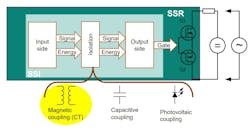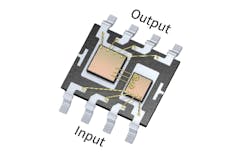Check out our coverage of APEC 2024.
In the world of power electronics, galvanic isolation prevents the undesirable flow of DC or AC current between different parts of a circuit or system while allowing for the safe transfer of signals and power. Isolation is invaluable in any system where it’s necessary to deter high voltages from causing permanent damage to more fragile parts of a power supply or system.
In a bid to bring faster performance, more robust isolation, and higher reliability switching to electronic relays, Infineon Technologies recently rolled out a family of solid-state isolators (iSSIs) at APEC 2024.
Based on the company’s proprietary “coreless transformer” technology to isolate signals or power and safely deliver them within a system, the iSSI facilitates faster and more reliable switching for power FETs at the heart of electronic relays. The new isolators, which can transfer 20X more energy than their predecessors, are used primarily to block electrical current feedback in power or control systems.
On top of superior power-handling properties, Infineon said iSSI delivers better energy efficiency, signal integrity, and reliability while extending the lifespan of high-voltage systems compared to the standard optoisolator. The features are also relevant in battery-management systems (BMS) for electric vehicles, large-scale energy storage, renewable-energy systems, as well as industrial and building automation applications.
More specifically, the ICs are designed to be used in electronic relays, which supply electrical isolation to a system, safely deliver power inside a system, or support the switching of smaller currents in control circuits (e.g., building automation and industrial control).
The iSSIs have internal current and temperature protection, giving them higher reliability relative to optoisolators used in other electronic relays and electromechanical relays that open and close physical contacts to turn on or turn off signals.
“Implementing coreless transformers in solid-state isolators and relays is truly a game-changer for power engineers,” said Davide Giacomini, Infineon’s head of marketing for Green Industrial Power.
The Essential Role of Galvanic Isolation
Galvanic isolation is invaluable in the world of power electronics for reliability and safety, stated Dan Callen, Infineon’s senior manager of product marketing for industrial automation.
Specifically, it’s required to separate the high- and low-voltage power domains of a system, which helps protect against permanent damage due to high-voltage transients and keep anyone close to a system safe from shock hazards.
“More low-voltage products are finding their way into the power electronics realm due to preventative maintenance and reliability,” said Callen. “Communications such as serial ports and protection circuitry such as overcurrent and overtemperature sensing are some examples.”
Galvanic isolation is also useful for connecting the sections of a power supply with different ground potentials or breaking up the ground loops by preventing current flow between the sections of a system that share a ground. Furthermore, the new isolators and other forms of isolation can help eliminate the electrical noise coupling from signals traveling through power electronics. When power supplies are tied together in a system, ground-loop currents tend to be induced because of slight differences in ground potential.
The new isolators, which belong to the same family as its gate-driver ICs, are designed to be compatible with the company’s wide range of power switching devices, including its families of MOSFET and IGBTs.
As galvanic isolation becomes even more vital in high-voltage systems, the movers and shakers in the semiconductor industry are investing in many new innovations, including the opto-emulator from TI.
Callen said he sees the semiconductor industry moving to even higher isolation voltages in the future.
Coreless Transformers: Isolation in Chip Form
One of the most popular ways to implement signal and power isolation is the optoisolator. These chips, also called optocouplers, facilitate the safe transfer of signals and data from the input stage in a power supply and its output terminals or load. They’re typically implemented in a way to isolate the high- and low-voltage zones of the system or eliminate electrical noise coupling from signals traveling through it.
The optocoupler will safely deliver the pulse-width-modulated PWM signal from the MCU or other controller in the power supply. It uses light to transfer signals through a physical boundary inside the device, which effectively isolates one side from the other.
In power electronics, optocouplers can be applied to everything from the input and output switching of the processor in a system to DC and AC power control. They’re useful for regulating the power supply's output voltage. When output voltage deviates either due to line and/or load changes, a power supply’s MCU adjusts the PWM output. The PWM travels through the optocoupler to direct the MOSFET on the primary side.
But as everything from BMS in EVs to energy-storage and renewable-energy systems upgrade to higher voltages, semiconductor companies are under pressure to bring even more robust isolation components to the table. The iSSI fits into high-density power systems “in that it can drive high-voltage MOSFETs that switch more drain current” than usual optoisolators, said Callen.
The iSSIs are rated for up to 5.7 kV RMS of isolation, which enhances safety in a wide range of electrical systems, ranging from medical and industrial control to other renewable-energy equipment.
Infineon said it uses semiconductor material in its isolators to recreate the isolation inside optoisolators. The isolation boundary is based on its “coreless transformer” technology, which leverages magnetic coupling in underlying semiconductor devices to block high-voltage transients as effectively—or more effectively—than optoisolators, while allowing for the desired signal or power flow to travel unrestricted through it.
One of the other advantages of the iSSI is that it has significantly less resistance than typical optoisolators, giving them the ability to be used in high-voltage and high-density power systems, said Giacomini.
High-Voltage Power Designs Hinge on Isolation
The coreless transformer at the heart of Infineon’s iSSI stands out in that it can transfer larger amounts of energy over the isolation boundary compared to optoisolators that they’re replacing in relays. The isolators require very small amounts of power on the input side to switch strong power loads. As a result, the iSSI can handle almost any type of load. On top of that, Infineon said “it is sufficient to drive the output switches without the need for an additional isolated power supply.”
According to the company, the new isolators make it possible to create solid-state relays that can control loads of more than 1000 V and 100 A, while delivering complete galvanic isolation from the input to output.
Importantly, no power supply is required for the output of the device, said Infineon. The electronic relays based on the iSSI can implement control from the MCU or a microprocessor (MPU) over a high-power signal (for instance, switching of AC and DC loads). At the same time, it grants galvanic isolation between the logic part of the system and the high-power signals traveling through to the opposite side.
The isolators are also said to be more robust than optoisolators, as there are no moving parts or metal contacts prone to failure or deterioration over time. That translates to higher reliability.
In contrast, optocouplers tend to deteriorate over time due to the stress of constant exposure to high voltages, which can be detrimental to automotive- and industrial-grade systems with long lifespans.
The iSSI can also be used to propel the power FETs in relays more efficiently, reducing power dissipation up to 70% compared to silicon-controlled rectifiers (SCRs) and other switching technologies. That reduces or even eliminates the heatsink required in the system, which saves space. The chips integrate a Miller clamp to prevent noise caused by transient voltages (dv/dt) from inadvertently turning on the switch.
Since it can facilitate faster switching speeds, Infineon said the iSSI has faster response times to high-voltage transients than other types of relays, which is a boon to high-speed signal processing and high-density power supplies.
Infineon said the iSSI also has a smaller form factor than other isolation components, and it can tolerate a larger amount of electrical noise. For high reliability, it also features fast overcurrent protection to stay inside the power transistor’s safe operating area (SOA).


